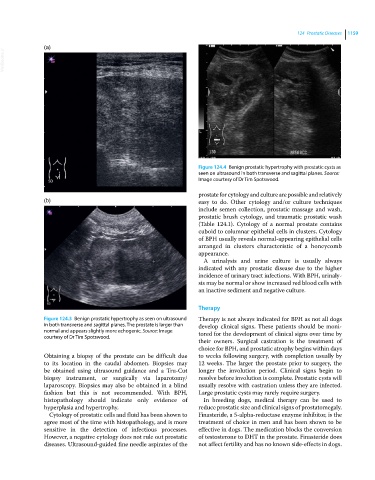Page 1221 - Clinical Small Animal Internal Medicine
P. 1221
124 Prostatic Diseases 1159
(a)
VetBooks.ir
Figure 124.4 Benign prostatic hypertrophy with prostatic cysts as
seen on ultrasound in both transverse and sagittal planes. Source:
Image courtesy of Dr Tim Spotswood.
prostate for cytology and culture are possible and relatively
(b) easy to do. Other cytology and/or culture techniques
include semen collection, prostatic massage and wash,
prostatic brush cytology, and traumatic prostatic wash
(Table 124.1). Cytology of a normal prostate contains
cuboid to columnar epithelial cells in clusters. Cytology
of BPH usually reveals normal‐appearing epithelial cells
arranged in clusters characteristic of a honeycomb
appearance.
A urinalysis and urine culture is usually always
indicated with any prostatic disease due to the higher
incidence of urinary tract infections. With BPH, urinaly-
sis may be normal or show increased red blood cells with
an inactive sediment and negative culture.
Therapy
Figure 124.3 Benign prostatic hypertrophy as seen on ultrasound Therapy is not always indicated for BPH as not all dogs
in both transverse and sagittal planes. The prostate is larger than develop clinical signs. These patients should be moni-
normal and appears slightly more echogenic. Source: Image tored for the development of clinical signs over time by
courtesy of Dr Tim Spotswood.
their owners. Surgical castration is the treatment of
choice for BPH, and prostatic atrophy begins within days
Obtaining a biopsy of the prostate can be difficult due to weeks following surgery, with completion usually by
to its location in the caudal abdomen. Biopsies may 12 weeks. The larger the prostate prior to surgery, the
be obtained using ultrasound guidance and a Tru‐Cut longer the involution period. Clinical signs begin to
biopsy instrument, or surgically via laparotomy/ resolve before involution is complete. Prostatic cysts will
laparoscopy. Biopsies may also be obtained in a blind usually resolve with castration unless they are infected.
fashion but this is not recommended. With BPH, Large prostatic cysts may rarely require surgery.
histopathology should indicate only evidence of In breeding dogs, medical therapy can be used to
hyperplasia and hypertrophy. reduce prostatic size and clinical signs of prostatomegaly.
Cytology of prostatic cells and fluid has been shown to Finasteride, a 5‐alpha‐reductase enzyme inhibitor, is the
agree most of the time with histopathology, and is more treatment of choice in men and has been shown to be
sensitive in the detection of infectious processes. effective in dogs. The medication blocks the conversion
However, a negative cytology does not rule out prostatic of testosterone to DHT in the prostate. Finasteride does
diseases. Ultrasound‐guided fine needle aspirates of the not affect fertility and has no known side‐effects in dogs.

